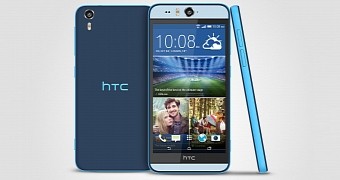Even though we knew the HTC Desire Eye would be a very powerful smartphone, we did not think that the smartphone would be able to steal the One M8’s flagship crown.
After taking a glance at what these high-end smartphones have to offer, it’s pretty clear that the competition will be fierce and customers will have to think it through thoroughly before deciding which one to buy.
The differentiator factor is clearly the design aspect and those who prefer premium smartphones will definitely choose the HTC One M8 over the Desire Eye due to its metallic chassis.
The One M8 is a metal-clad smartphone, while Desire Eye is all plasticky
There’s no doubly about it, the One M8 is still the best-looking smartphone launched by HTC, but the Desire Eye is not far away either. It’s the plastic that keeps HTC Desire Eye’s components together that might not appeal to those more attached to premium smartphones.
However, specs-wise, the Desire Eye does seem to offer slightly more punch than the One M8. Anyway, let’s see what these top-tier devices are capable of, so we have a better glimpse at what’s to come later this month.
First of all, HTC Desire Eye sports a 5.2-inch display that supports full HD (1080p) resolution, while the HTC One M8 has a slightly smaller 5-inch display with the same resolution.
The hardware configuration is similar, as both handsets are equipped with a 2.3GHz quad-core Qualcomm Snapdragon 801 processor, an Adreno 330 graphics processing unit and 2GB of RAM. They also come with 16GB of internal memory and microSD card slot for memory expansion (up to 128GB).
HTC Desire Eye is the new king of selfie smartphones
The main difference is the camera. The new HTC Desire Eye is likely to be the king of selfie smartphones with a 13-megapixel front-facing camera that features dual-LED flash (dual-tone) and full HD (1080p) video recording capabilities.
The HTC One M8 packs only a 5-megapixel camera in the front and a 4-UltraPixel camera on the back, which features dual-LED flash and full HD video recording. The Desire Eye’s rear-facing camera has 13-megapixel and a similar dual-LED flash.
The Desire Eye is powered by a 2400 mAh Li-Ion non-removable battery, but the One M8 does seem to be better in this respect as the smartphone drains energy from a 2600 mAh Li-Polymer battery.
This should have been easy to assess, but HTC claims the Desire Eye’s battery should last for up to 538 hours of standby time or up to 20 hours of talk time, whereas the One M8’s is rated for up to 496 hours of standby time or up to 20 hours of talk time.
Connectivity-wise, both high-end Android smartphones are similar
Moving on to connectivity, both smartphone offer similar options, including LTE Cat.4, Wi-Fi, Bluetooth 4.0, microUSB 2.0, GPS with A-GPS and GLONASS, as well as NFC (Near Field Communication).
Another differentiator would be the fact that HTC Desire Eye is IPX7 certified, which makes it dust and water proof (up to 1 meter for up to 30 minutes).
Customers will have a tough choice to make, as both HTC smartphones offer almost similar features with few differences. And it will be even tougher knowing that both HTC One M8 and HTC Desire Eye cost the same. Which one would you choose and why?

 14 DAY TRIAL //
14 DAY TRIAL //